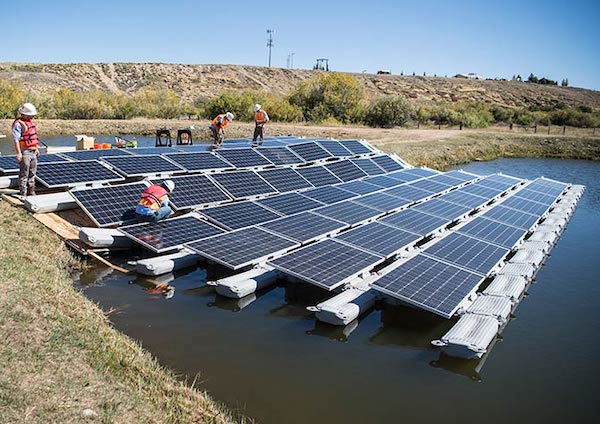Holy Floating Solar Panels, Batman (Now With Tracking)!
If you think the world is ready for a floating solar explosion, run right out and buy yourself a cigar. It’s happening! The idea of strewing solar panels about bodies of water like so many rose petals has finally caught on, and here in the US it’s getting a major push from the US Department of Energy. No, really!

We’ll get to the Energy Department in a minute, but first let’s take a look at the latest floating solar news.
Yet Another Floating Solar Farm In The Netherlands
Earlier this month CleanTechnica profiled a new solar panel array under construction in the northeastern Netherlands, which will float upon a former sand extraction site.
The latest news comes from the Netherlands, where Guardian reporter Daniel Boffey reports that 15 sunflower-like solar arrays, totaling 73,500 solar panels, are under construction on the Andijk reservoir in north Holland.
Boffey sites NIMBY resistance to land-based solar farms as one key motivation for putting solar panels on bodies of water.
Other large floating solar arrays are currently under construction here and there around the globe. The Andijk project stands out for its size (largest of its kind in the world), and also for an automatic buoy-and-anchor system that enables each island to turn toward the sun for optimal efficiency.
Floating Solar Is A Tough Cookie
Evidence is mounting that solar panels can stand up to extreme conditions, including deserts (think dust as well as heat), cold climates (solar panels work more efficiently in frigid temperatures and snow reflection also helps), and even hurricanes.
The environment around Andijk presents another type of challenge, with frequent storms kicking up high winds and choppy water. When a storm comes up, the tracking system automatically shifts gears and moves the islands into a position that enables wind and water to pass through safely.
Consistent with the finding that solar panels work more efficiently in cold temperatures, the water has a cooling effect that optimizes the efficiency of floating solar arrays. Reflection from water can also increase solar cell efficiency.
It’s A Solar Panel, Therefore It Floats
What are we leaving out? Oh right, the US Department of Energy. Regardless of the Commander-in-Chief’s* enthusiasm for fossil energy, DOE has been doggedly pursuing a renewable path to the sparkling green grid of the future, and lately that path has veered into floating solar territory.
The agency’s National Renewable Energy Laboratory has been making a major pitch for deploying floating PV arrays all across the country.
In a blog post last year, the lab reported that its Solar Technical Assistance Team has been peppered with requests for information about floating solar. Among the advantages, the lab cites efficiency gains from lower temperatures, the potential for packing more solar panels into one spot, and reduced costs for land acquisition and site preparation.
Environmental concerns can include the impact of creating permanent shadows on the bottom of a body of water. The Andijk project works around that by moving the location of the islands.
On the plus side, NREL notes that floating solar arrays can reduce evaporation in bodies of water.
10% Of US PV Potential Could Be Waterborne
So, here’s where it gets interesting. Last December, NREL set the Intertubes on fire with a report that floating solar could produce almost 10% of the nation’s electricity supply.
That’s not likely to happen — or, maybe it is.
The new floating PV report was the first of its kind in the US, and NREL took a conservative approach regarding site selection. The lab *only* included 24,419 human-made reservoirs in the US. That figure represents just 27% of the human-made water bodies in the US.
The researchers also narrowed down the initial selection of 24,419 sites by taking economics into consideration. They focused on areas where the high cost of farmland could create an incentive for solar developers to look for water-based sites.
NREL also focused on regions where high rates of evaporation would create an incentive to cover bodies of water with solar panels.
CleanTechnica is speaking with NREL later this week about a new cutting edge renewable energy R&D initiative, so stay tuned for more news about floating solar panels.
From: https://cleantechnica.com/2019/04/22/holy-floating-solar-panels-batman-now-with-tracking/

